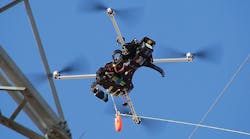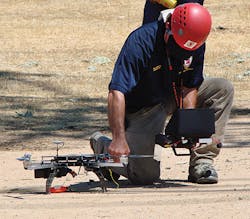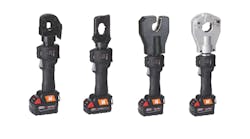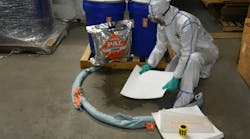In April, workers who operate or maintain electric power generation, T&D lines or similar equipment must use fall protection when climbing or changing location on poles, towers or similar structures. OSHA estimates that the update to OSHA 1910.269 will prevent at least an additional 118 workplace injuries and 20 fatalities annually.
All electric utility workers in the U.S. will be required to be 100% attached while climbing. This represents a major change in the climbing industry that affects utilities, equipment suppliers and those who provide training.
Devising a Solution
Safety One Training International, which offers fall protection and rope access courses for workers and supervisors in the climbing industry, initially looked at training for implementing the new OSHA rule. However, recognizing the difficulty of using training alone to meet these requirements, the company came up with a completely different approach.
The solution came in the form of an unmanned aerial vehicle (UAV). Art Seely, founder and CEO of Safety One, and one of his tower climbing instructors are remote control airplane hobbyists. In the early 2000s, Seeley pioneered the technique of flying a remote-controlled aircraft out of line-of-sight using UAV-mounted cameras and ground station monitors. This is now called first-person view.
Using a similar principle, they came with the idea to use a helicopter drone to carry a P-line to the top of a tower and drop it down the center or over a desired support point. Then the P-line is used to pull up a specially rigged three-part climbing rope. To allow linemen to climb 100% attached, utilities must sling a line up over the structure with secured ground attachments for all the workers to attach to. In the past, a sole climber or “first man up” set the initial line.
The UAVs, or drones, can quickly establish a rated climbing rope over 350-ft structures, complete with ground attachment points, typically in 5 to 10 minutes. With this completed, all climbers can safely ascend transmission structures in full compliance with new OSHA regulations in less than one-quarter the time of the best alternative methods being considered.
Testing Out the Drone
Over the course of 30 days, Safety One assembled the necessary accessories to build a small off-the-shelf quadracopter drone, then spent time to perfect and patent several critical additions to the UAV to carry out basic and advanced functions. For example, when linemen must put the P-line through side openings on a structure, they can use a P-line gun.
After first testing around live radio transmission towers, they hooked up the extra electronics to stabilize both it and a remote dropable P-line. Then they tested it on the training towers at Safety One’s facilities in Littleton, Colorado. They also developed line carry and deployment systems to work around energized equipment.
They questioned, however, if the drone would the drone work around live 350-kV lines without interrupting radio control signals or digital video feeds. To test it out, a group of Safety One employees took a small quadracopter to a live line and flew within 1 ft of the wires without a problem. Later, they conducted confirming tests. Western Area Power Administration is scheduled to conduct a high-voltage test of a quadracopter in contact with a 500-kV line inside its test chamber in Sacramento, California. Southern California Edison, Sacramento Municipal Utility District and Pacific Gas & Electric also have expressed serious interest in the project with support and encouragement.
Creating Other Accessories
Safety One has already patented several innovations related to the concept. This includes a device where the P-line spooling out from on the ground can sense any current coming down the P-line, which could happen if it got wet. Then, it sounds an alarm to ground crews. The lines are nonconductive, but specialized payloads could spray solvents or oils onto exposed tower components.
They also custom built a forward-looking infrared (FLIR) camera to use in addition to the standard visual camera. This thermal image camera was custom engineered and manufactured to spec to be the smallest full-featured FLIR in the world. They also developed a military-grade, one-eye, heads-up display unit so the operator can view live feed from thermal or visual camera while keeping both eyes on flying the UAV. In addition they have the capability to carry an ultraviolet camera and Light Detection and Ranging (LIDAR) systems.
Their newest UAV under development has a lifting capacity of 50 lb for 8 minutes so miniaturization of equipment is not a necessity. Safety One has also developed a pickup truck-mounted launch and landing platform.
Training Field Crews
Safety One offers three initial training courses for drone operators to complement existing programs in climber safety, rope access, snow cat operation and winter survival training. These include Standard Flight Operations, Advanced Flight Operations and UAV/Drone Program Administration. The goal is to help choose the right UAV, learn how to fly it correctly and safely, and avoid many of the pitfalls. This includes custom training and custom-built drones specifically for particular applications.
UAVs are just one aspect of a utility’s rope access program. Planning, training and equipment are needed to address the challenges of the new OSHA regulations. Safety One provides the additional consulting and training programs to implement the 100% attachment climbs with or without a drone.
As utilities gear up to abide by the new OSHA regulations, they are looking for ways to protect their field workforce, modify their structures and invest in new fall protection equipment. Through the drone technology, they can help make the tower climbing safer for their linemen in the field.




